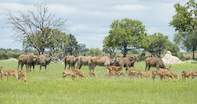
Zimbabwe is a landlocked country at the base of the African continent. Its neighbours are Zambia in the north, Mozambique in the east, South Africa to the south and Botswana in the west. The northeastern border of the country is marked by the mighty Zambezi River, along which is located the incomparable spectacle of Victoria Falls and the magnificent expanse of Lake Kariba.
These Zimbabwe Safari Tours offer a range of experiences, from the adrenaline activities of the Victoria Falls, to the wildlife of Hwange National Park, and canoeing in Mana Pools National Park.
Victoria Falls Safari
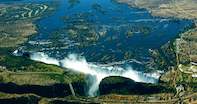
Victoria Falls, like Mount Kilimanjaro, is an emblem of the entire African continent. Spanning 1700 metres (5577.4 feet) and dropping 128 metres ( 420 feet) into the Zambezi Gorge, the falls create a roar--and a cloud of mist--so great that they are visible from 40 km (24.8 miles). David Livingstone was the first European to visit the falls, in 1855, and he named them in honor of his queen.
The best time to visit Victoria Falls is between September and November. During March and April, when the water volume is at its peak, the falls create so much mist that they are difficult to see, and from May to September the mist adds to the season's high humidity.
There are all sorts of activities offered at Victoria Falls, including bungee jumping, small plane flights over the falls, and raft trips to the Boiling Pot at their base. In addition to such thrill ride activities, Victoria Falls is also the center for some of the best safari and adventure tours in Africa.
Zimbabwe Safari Tours and Lodges
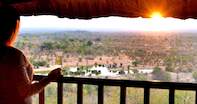
Wildlife and game viewing are the main attraction at these Zimbabwe Safari Lodges. Game viewing activities include game drives, nature walks, canoeing safaris and cruises.
Hwange National Park
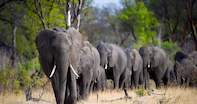
Hwange National Park, located about 1 hour south of Victoria Falls and along the Botswana border is the largest park in Zimbabwe. It enjoys one of the highest concentrations of wildlife in the country, and is particularly renowned for its great numbers of Elephant. Hwange National Park is connected to several private reserves that offer less restricted and far more pleasurable game viewing-including both guided safari walks and night game drives.
Mana Pools National Park
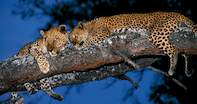
More National Parks and Reserves in Zimbabwe
Although Zimbabwe has experienced political strife in recent years, the country boasts many national parks and game reserves worth visiting. Read more...Zambezi National Park
Above Victoria Falls, outstanding canoe and kayaking safaris are available, offering one of the most exciting and memorable ways to experience both the Zambezi and the abundant game of Zambezi National Park. Below Victoria Falls, the Zambezi becomes a whitewater rafting paradise. The rafting trips that run through the river gorges are internationally known as the most exciting, and least dangerous, to be found anywhere.
Gonarezhou National Park
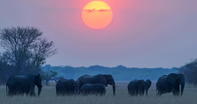
Most of the border with Mozambique is consumed by this massive park, which contains over 2,000 square miles of open wilderness. Gonarezhou is Zimbabwe's second largest park. Gonarezhou means refuge for Elephants, and they are among the main attraction at the park.
It was here that one of the largest Elephants ever recorded was shot and killed by the famous poacher Cecil Bernard in the 1920's. His name was Dhlulamithi, taller than the trees, and one of his tusks weighed 110 kilograms (242.5 pounds). Other game such as King Cheetah and Nyala and Suni Antelope are equally abundant, especially near the Runde River.
Lake Kariba
Further east, and further downstream from Victoria Falls, is located this enormous almost 5200 square km man-made lake. Formed in 1958 by the damming of the Zambezi at Kariba, the lake is now an attraction in its own right. Its scattered islands, clear, deep waters, and adjoining game reserve complement each other admirably.
The reserve, Matusadona National Park, was begun as a refuge for animals saved from the rising waters of the lake itself. Today, its abundant game gathers along the lake shore, particularly in the dry months, where it is easily viewed from the water. Zimbabwe's fine small houseboat lodges are located here, and the Lake also serves as the starting point for canoe safaris to Mana Pools National Park.
Matobo National Park
The landscape of this small southern park is somewhat unnerving. All throughout Matobo National Park, on hundreds of small hills, are precariously balanced free from stacks of granite boulders. Cecil Rhodes was buried on one such hill, located just a few kilometres from the park entrance and offering a panoramic view out over the plain.
With so many fine perches, it is unsurprising that Matobo has the greatest concentration of Black Eagle in the world. Other bird species abound as well, as do many different species of game animals. Matobo also attracts visitors to its thousands of rock paintings, many of which are amazingly well-preserved.

 Victoria Falls safaris aren’t like any other African safaris. The Zimbabwe side of the Victoria Falls gets more visitors than the Zambian ...
Victoria Falls safaris aren’t like any other African safaris. The Zimbabwe side of the Victoria Falls gets more visitors than the Zambian ... Zimbabwe in Southern Africa, is blessed with spectacular variety and beauty. Discover the best Zimbabwe safari and holiday destinations....
Zimbabwe in Southern Africa, is blessed with spectacular variety and beauty. Discover the best Zimbabwe safari and holiday destinations.... Everything you need to know about going on safari in Zimbabwe. Find out about elephants in Hwange National Park, tour Lake Kariba, visit Man...
Everything you need to know about going on safari in Zimbabwe. Find out about elephants in Hwange National Park, tour Lake Kariba, visit Man... A collection of Zimbabwe safari tours and Zimbabwe safari lodges, combining wildlife safaris and amazing scenery....
A collection of Zimbabwe safari tours and Zimbabwe safari lodges, combining wildlife safaris and amazing scenery....